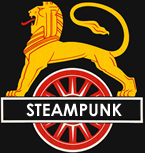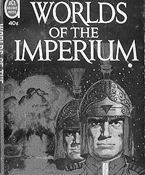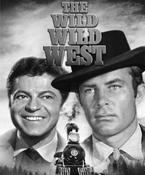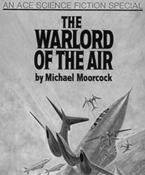 THE GATEHOUSE
THE GATEHOUSE
“The origins of steampunk, Part I” (1962-72)
By N. Ottens (11 June 2008)
Although the term “steampunk” was not phrased until 1987, several works of fiction significant to the development of the genre were produced throughout the two decades prior—a selection of which we shall discuss here.
Imperium
The Imperium series of John Keith Laumer (1925-93), a former U.S. Air Force officer and diplomat, of which the first installment, Worlds of the Imperium, was published in 1962, features a continuum of parallel worlds policed by an Imperium governed from an alternate London which never saw the disgrace of the American Revolution, nor the horror of the Great War. Laumer’s protagonist is rapscallion American diplomat Brion Bayard, spirited away from the streets of Stockholm. Why and to where is the crux of the story as we travel to a gas-lit gilded world where nineteenth-century pomp, brass, and imperial hubris never went out of style, and the Russian revolution was a no-show.
Travel through time and parallel universes is an hazardous endeavour. Fortunately, our world is an island of tranquility amidst multiversal desolation, yet over in B-I Two, a planet obliterated by nuclear horror, trouble is afoot as savage warlords have just discovered trans-dimensional flight. Bayard travels to Algiers to neutralize his doppelganger, dictator of that wretched world now attacking the Imperium with guerilla atom raids.
Though Imperium might not be perfectly steampunk quite yet, it does for the first time merge Victorian aesthetics with futuristic technology. A sequel to Worlds of the Imperium, entitled The Other Side of Time, was pubished in 1965, with further installments to follow in 1968, 1981, and 1990.
The Wild Wild West
More contemporary steampunk enthusiasts might be familiar with the quintessential “Weird West” motion picture, Wild Wild West (1999), not aware that said film was actually based upon the television series of the same name which ran for four seasons from 1965 till 1969. Developed at a time when the television western was losing ground to the spy genre, owing to the immense popularity of Goldfinger, released but a year before, the show was conceived by its creator, Michael Garrison, as “James Bond on horseback.”
The Wild Wild West features two Secret Service-agents, one a charming gunslinger, the other a brilliant gadgeteer and master of disguise, on constant mission to protect the President of the United States, Ulysses S. Grant. In vein of James Bond, the agents, traveling about the country aboard their luxurious train, encounter beautiful women, handle clever gadgets, and thwart the half-insane plots of delusional villains to take over the country, or the world.
Though The Wild Wild West takes place across the Atlantic—a continent not often featured in steampunk&mdash, the image of their gadget-filled train puffing through the frontier of America while the agents themselves embark on adventures whimsical and comical alike, makes for a specimen of proto-steampunk which we certainly cannot deny.
Queen Victoria’s Bomb
Ronald W. Clark (1916-87), correspondent during World War II and biographer and novelist throughout his years thereafter, often wrote about the atomic bomb and was the first to bring this destructive force into the Victorian Era. In Queen Victoria’s Bomb, physicist Franklin Huxtable believes he has found the way to end all war; a device that can vaporize an area of land within a one-mile radius, reducing every living thing within to “their original elements.” Huxtable has the weapon tested upon the presumed-deserted Jubila Plateau in India but is forced by Queen Victoria herself to keep his invention a secret from the rest of the world. For decades, Huxtable sees wars in the Crimea and the United States wreck havoc and destruction, throughout his lifetime unable to make his dream of ending armed conflict publicly known.
Besides the obvious steampunk characteristic of transporting a modern-day technology into the past, Clark’s novel also features many references to nineteenth-century celebrities and events in the vein of George MacDonald Fraser’s Flashman series, of which the first installment was published in 1969. Huxtable meets Queen Victoria and her husband Albert, Florence Nightingale, and Hiram Maxim, inventor of the infamous machine gun. Another historical figure more prominently featured is Sir Joseph Dalton Hooker, botanist and explorer who traveled about the British Raj during the mid-century. It is through Hooker that Huxtable becomes aware of mutated plant specimens growing in the vicinity of the Jubila Plateau, and a native tribe living a few miles downwind from the atomic explosion whose members have been afflicted with all manners of deformity.
Queen Victoria’s Bomb might best be categorized as alternate history rather than steampunk, for the novel focuses little on steam power and finds its anachronism in a technology nowadays more associated with dieselpunk. Nonetheless, as evident from the aforementioned Flashman series, as well as the following installments of proto-steampunk, Clark’s tale of Huxtable and his bomb may have helped popularize the nineteenth-century as setting for stories which are really more about the time in which they are writting rather than the era in which they take place.
The Warlord of the Air
Science fiction author Michael Moorcock (1939) made numerous contributions to steampunk throughout his career, The Warlord of the Air, published in 1971, being but the first of several stories set in an anachronistic Victorian Era. Sequels to said novel were published in 1974 and 1977, while his The Dancers at the End of Time series, featuring time-travel to nineteenth-century London, was collectively published in 1981.
The Warlord of the Air concerns the history of Oswald Bastable, an Edwardian era British soldier stationed in India who finds himself transported over a half a century into the future; a future in which the First World War never occured and the mighty airships of a British Empire on which the sun failed to set are threatened by the rise of a dreadful new foe: anarchist rebels who seek to liberate the oppressed nations of the world from the iron grip of imperialism. Bastable joins their cause and succeeds tragically in provoking war amongst the greater powers to break down their power; the city of Hiroshima is bombed at the hands of the anarchists. Wracked with guilt over his part in the destruction of countless millions of innocent lives, and dreading the future of science and imperialism gone mad, Bastable escapes the terrible time he created and disappears.
Throughout the narrative, Bastable encounters several historic figures, ranging from Winston Churchill, former Viceroy of India, to Vladimir Lenin, aged revolutionary in a world which never saw a Russian Revolution. The Warlord of the Air, as well as its sequels, Moorcock explores racism, imperialism and the impact of technology, setting several of the themes which would come to define steampunk fiction.
Zeppelin vs. Pterodactyls
We would not quite live up to the premise of our genre were we not to fix our gaze upon what could have been also, thus a brief discussion of the failed Hammer Film productions, Zeppelin vs. Pterodactyls, is certainly in order.
The British Hammer Film Productions company was renowned throughout the 1960s and early-1970s for its gothic “Hammer Horror” films, producing so much as six Frankenstein and eight Dracula installments between 1959 and 1974 alone. Zeppelin vs. Pterodactyls, however, was sadly never produced; the impressive poster artwork was done to attract investors whom obviously did not share Hammer’s enthusiasm for such a dieselpunk adventure. Indeed, the story was supposed to be similar to The Land That Time Forgot (1975), which was based upon the 1918 novel of the same name by Edgar Rice Burroughs and saw its screenplay written by Michael Moorcock—a German zeppelin blown off-course during a bombing raid of London and winding up in lost world where dinosaurs still roamed.
A Transatlantic Tunnel, Hurrah!
Science fiction author Harry Harrison’s (1925) contribution to steampunk came in 1972 with the publication of an alternate history adventure which depicts the world still firmly ruled by the British Empire. Set in 1973, A Transatlantic Tunnel, Hurrah!, also published as Tunnel Through the Deeps, presumes the American Revolutionary War lost by the North American colonists, thus America still under control by an ascendant but benevolent and utopian British Empire. The novel’s protagonist, Augustine Washington, is a direct descendant of George Washington, who was obviously shot as a traitor after his dismal defeat. Augustine joins forces with a Sir Isambard Brassey-Brunel, himself descendant of the famed engineer, to link the heart of the Empire with its far-flung Atlantic colony.
Though not actually set in the Victorian era, Harrison’s narrative does depict a world in which Britannia still rules the waves and marvels of technological wonder are achieved for the glory and support of the British Empire. Furthermore, said narrative is particularly Victorian nonetheless, where the author seeks to evoke the sensation of period literature, thus paving the ground for numerous authors yet to write steampunk.
Please select one of the titles listed below to proceed to your article of choice.
• “The origins of steampunk, Part I,” by N. Ottens (2008)
In which we trace of the origins of steampunk as a literary genre. This first part discusses the principal works of proto-steampunk. (1962-72)• “The punk-ness of steampunk,” by N. Ottens (2008)
In which we consider the meaning of punk to steampunk and the relevance of its rebellious spirit to the political philosophy of the movement.


Worlds of the Imperium, Keith Laumer (1962)

The Wild Wild West, CBS (1965-69)

Queen Victoria’s Bomb, Ronald W. Clark (1967)

The Warlord of the Air, Michael Moorcock (1971)
Zeppelin vs. Pterodactyls, Hammer Film Productions (1971)
A Transatlantic Tunnel, Hurrah!, Harry Harrison (1972), published in Analog Science Fact & Fiction.